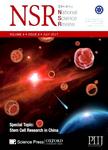Anthropogenic warming is a key climate indicator of rising urban fire activity in China
作者机构:National Institute of Natural HazardsMinistry of Emergency Management of China Key Laboratory of Sustainable Forest Ecosystem Management-Ministry of Education School of Forestry Northeast Forestry University Laboratory of Tree-Ring ResearchUniversity of Arizona Institute of Atmospheric PhysicsChinese Academy of Sciences Department of Statistics Colorado State University Department of Land Surveying and Geo-Informatics The Hong Kong Polytechnic University Key Laboratory of Humid Subtropical Eco-Geographical Process (MOE) College of Geographic Sciences Fujian Normal University Department of Building Environment and Energy Engineering The Hong Kong Polytechnic University
出 版 物:《National Science Review》 (国家科学评论(英文版))
年 卷 期:2024年第11卷第5期
页 面:110-120页
核心收录:
学科分类:03[法学] 07[理学] 070601[理学-气象学] 08[工学] 0837[工学-安全科学与工程] 0706[理学-大气科学] 0838[工学-公安技术] 0306[法学-公安学]
基 金:supported by the National Natural Science Foundation of China (32201573 and 32301599) the National Key Research and Development Program of China(2022YFC3003000)
主 题:fire–climate interactions global warming fire history network urban fires fire management
摘 要:China, one of the most populous countries in the world, has suffered the highest number of natural disaster-related deaths from fire. On local scales, the main causes of urban fires are anthropogenic in ***, on regional to national scales, little is known about the indicators of large-scale co-varying urban fire activity in China. Here, we present the China Fire History Atlas(CFHA), which is based on 19 947documentary records and represents fires in urban areas of China over the twentieth century(1901–1994).We found that temperature variability is a key indicator of urban fire activity in China, with warmer temperatures being correlated with more urban fires, and that this fire–temperature relationship is seasonally and regionally explicit. In the early twentieth century, however, the fire–temperature relationship was overruled by war-related fires in large urban areas. We further used the fire–temperature relationship and multiple emissions scenarios to project fire activity across China into the twenty-first century. Our projections show a distinct increase in future urban fire activity and fire-related economic loss. Our findings provide insights into fire–climate relationships in China for densely-populated areas and on policy-relevant time scales and they contribute spatial coverage to efforts to improve global fire models.



